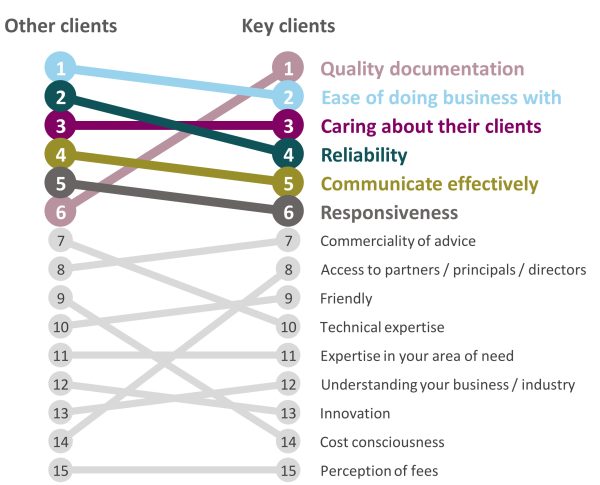If you work in professional services, you know it costs a lot to lose a client.
There’s not only the impact of reduced firm revenue now and in the future. There are also the operational costs involved in offboarding a lost client, the acquisition costs of finding new clients, plus reputational costs to the business caused by disgruntled former clients sharing their bad experiences with others.
Harvard Business Review has estimated it costs up to 25 times more to acquire a new client than to retain an existing one. Partner at Beaton Paul Bonomy says the actual dollar figure can reach into the millions.
“For a mid-tier law firm, a big client might generate between a quarter of a million up to a million dollars a year,” Bonomy says. “For bigger firms, their big clients might generate 10 to 20 million dollars a year. Losing that amount of revenue is not something to sneeze at.”
With so much at stake, it is vital that firms invest time and resources to retaining clients and enhancing client loyalty. But where to start? It might sound contrary – but you should start with the dissatisfied clients.
Why firms should seek to understand dissatisfied clients
Picture this: you’ve been using the same plumber for years. But recently, when you hired them to unblock your sink, their service was not up to scratch. They didn’t answer your phone calls promptly – you had to leave messages and chase them up. Then, they were late, appeared without the right tools, and were difficult to work with. At the end of it all, they charged more than you expected.
How would you feel? Disgruntled and probably ready to find a new plumber (while telling your friends and family to avoid the previous one).
Now, imagine this scenario in a professional services context. Feeling so dissatisfied after a job could be enough to make a client seek out a new firm – especially in today’s hyper-competitive market.
The tricky thing is it can often be very difficult for busy plumbers (and professional services firms) with other happier, loyal clients to understand what made you leave. Was it communication? The price? The service or attitude? To you, it may seem obvious. To the plumber (or firm): all they know is a client has left.
Drivers of satisfaction and dissatisfaction



Source: Actual firm’s client data
Improving client loyalty with a Dissatisfied Clients Diagnostic Report
Fortunately, there are less expensive ways to discover what frustrates your clients than by losing them. For many firms, participating in the annual Client Choice Awards is one way to obtain honest and regular feedback as the results are benchmarked against your firm’s competitors by a third party (Beaton), rather than clients responding directly to narrow surveys or questions sent out by your firm.
Obtaining net promoter scores (NPS) can also be useful to understand how likely clients are, on average, to recommend a firm to a friend or colleague. But the average score is just that – it will only find the middle number between dissatisfied and satisfied clients and cannot home in on the source of dissatisfaction. To go deeper, Beaton developed a specific feedback tool – the Dissatisfied Clients Diagnostic Report – to capture your frustrated clients’ views in detail.
Here’s how it works.
“First we need to understand whether your firm has dissatisfied clients – that’s the first question. If so, what proportion of the client base and what type of clients are dissatisfied?” Bonomy says.
“Once we have discovered the proportion and profile of clients who are unhappy, we can figure out how much revenue they bring in each year, what sectors they operate in and what sort of work you do for them. So, then we can start to analyse whether you need to respond and if so, how.”
The most valuable part, Bonomy explains, is how the report pinpoints the source of your client loyalty (or lack of it). The data ranks key drivers of dissatisfaction by attributes such as reliability, communication, quality documentation, responsiveness, innovation and fee perception by their order of importance according to your clients (spoiler alert – it is almost never fees that causes clients to leave). Your firm can then build a highly focused, efficient, and data-driven strategy to improve the attributes that clients value most.
What this dissatisfied client report does is it allows you to focus your remediation efforts on specific client segments and specific issues they are facing.
Paul Bonomy, Partner, Beaton
Stop with scattergun solutions: a targeted strategy to enhance client loyalty
Research done by Frederick Reichheld of Bain & Company (the inventor of the NPS) has shown increasing client retention rates by just 5 per cent can increase profit by 25 per cent to 95 per cent. As discussed above, the cost of losing a client is far greater than the cost of preventing them leaving.
Really, firms can’t afford not to diagnose their dissatisfied clients.
“What this dissatisfied client report does is it allows you to focus your remediation efforts on specific client segments and specific issues they are facing,” Bonomy says.
“So you’re not just offering a costly or time-consuming one-size-fits-all solution, which may not even work. With this tool, you can do something specific to address the problem – it allows you to allocate scarce resources to focus on a problem this is clearly articulated.”
To find out more about Beaton’s benchmarking products and how they can benefit your organisation please visit our Competitor benchmarking page or contact us to discuss your options with a Beaton partner.
NOTE: In keeping with Beaton’s confidentiality undertakings, individual clients and their organisations are never identified in blog posts or example studies.
Share these insights with a colleague
The corresponding post type is disabled. Please make sure to 1) install The7 Elements plugin under The7 > Plugins and 2) enable desired post types under The7 > My The7, in the Settings section.




